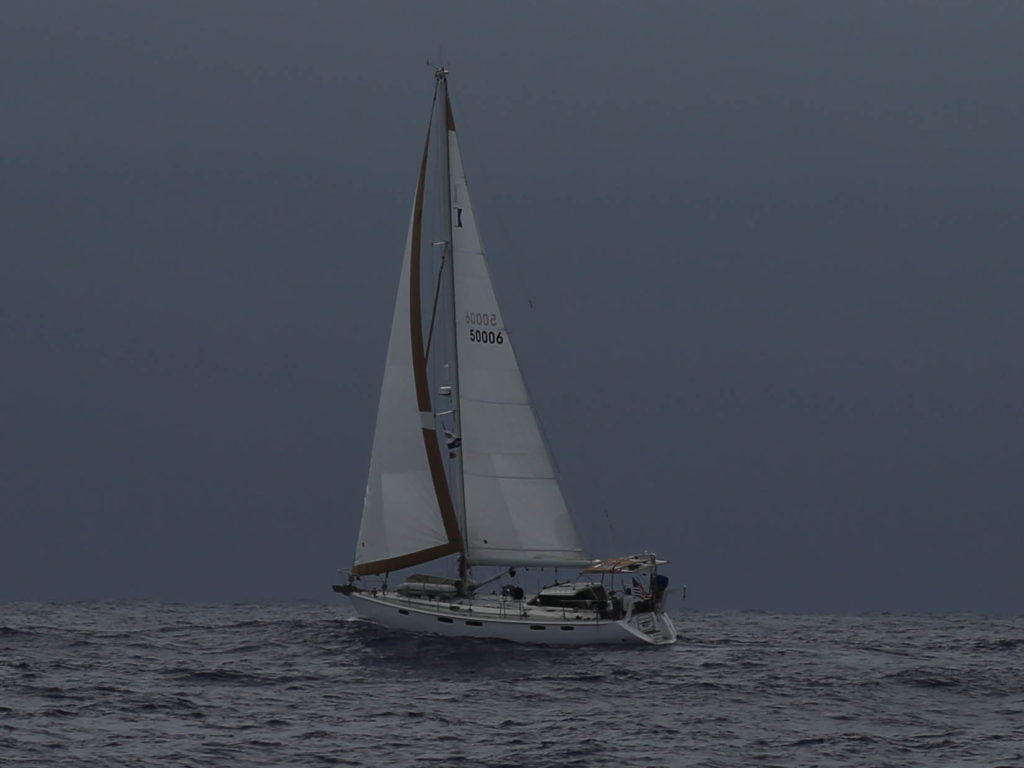
Dimensions: LOA: 51 feet LWL: 45 feet Beam: 14 feet Draft: 6’6″ Displacement: 33,140 pounds Ballast: 11,400 pounds Sail Area: 1,101 SF
Tankage: Fuel: 220 gallons, 3 tanks; Water: 220 gallons, 2 tanks
Ratios: Disp/Length-186, Ballast/Disp-.36, Sail Area/Disp-17.07
Production History – The Apogee 50 was designed by Chuck Paine and built by Able Marine in Trenton, Maine. Our research shows at least nine were built before Able Marine was sold to Morris Yachts. Morris then built a series of these boats called the Morris 51. Interestingly both builders won the Cruising World’s Boat of the Year Award years apart with the same design. Morris Yachts was acquired by Hinckley Yachts in 2016 which achieved some economies of scale since all three yards were located within a few miles of each other. The boats were semi-custom with options on mast material, standing rigging, keel depth, raised salon, cabin layout, interior finish, and hard dodger. We have a carbon fiber mast, rod rigging, hard dodger, medium keel depth, low salon, cherry interior, and the pullman forward berth options. Renegade was hull number six, delivered to her owners in 1997 and originally named Aponivi. Built for short handed offshore passage making, several have circumnavigated the globe, rounded the Horn, and cruised the arctic and antarctic circles.
Design Features – During the boat search process we never expected to encounter a boat designed to check off most of our wish list. Starting with safety and serviceability, the design has three watertight compartments, one of which is the dedicated aft mechanical room. The mechanical room allows full access to the engine, generator, watermaker, rudder shaft, autopilot, water heater, fuel filtration system, fuel transfer system, raw water intake sea chest, as well as a neat workbench. The hull is lined with Kevlar and one Apogee owner reported he was the only GRP boat he saw in the Antarctic able to handle the growlers damage free. Speed to get out of the way of storms is an important safety measure for us as well. The long waterline and shorter beam create a design that records 200 mile daily passages with an easy motion in the seaway that resists the tendency to pound. We were skeptical of spade rudders on a cruising boat, but Apogees have two massive self-aligning bearings with an anti-stall blade and a shaft which are ruggedly fabricated of carbon fiber (no rust failure). To take full advantage of upwind sail shape (we can’t give up on our racing past yet) as well as easily manage, the full batten mainsail is stored in the Leisurefurl in-boom system. For headsails we have twin furling 120 genoa and staysail. Finally, as liveaboards, it is important to feel like you are at home. The rich cherry interior, beautiful joinery, along with hull ports and ample hatches bring in light produce a very comfortable cabin.
2018/2019 Refit – We looked at a lot of boats and would have never predicted getting one of this age. Renegade was a well cared for northeastern boat put away every winter and commissioned every spring with Atlantic crossings under her belt. A GRP boat of this build quality can last almost forever if maintained. We speculated if we got the right price and her systems were brought up to date, we would have a real cruising machine superior to the other boats we were considering. We front loaded some work so the boat should have minimal need for major upgrades in the next decade if well maintained. The project list included hull painting, bottom job, mast/boom painting, sails, boom service, running rigging, deck clutches, refrigeration, water maker, engine, generator, fuel supply, lithium iron phosphate house batteries, engine & generator batteries, almost all electronics, solar, tank cleaning, bimini, pumps, almost all plumbing, toilets, dinghy, and anchor.
Links:
Cruising World Able Apogee Boat of the Year Article
Cruising World Morris 51 Boat of the Year Article
Boat tour Living Space and Front & Aft
Boat selection process Part 1, Part 2, Part 3, Part 4, Part 5, Part 6
